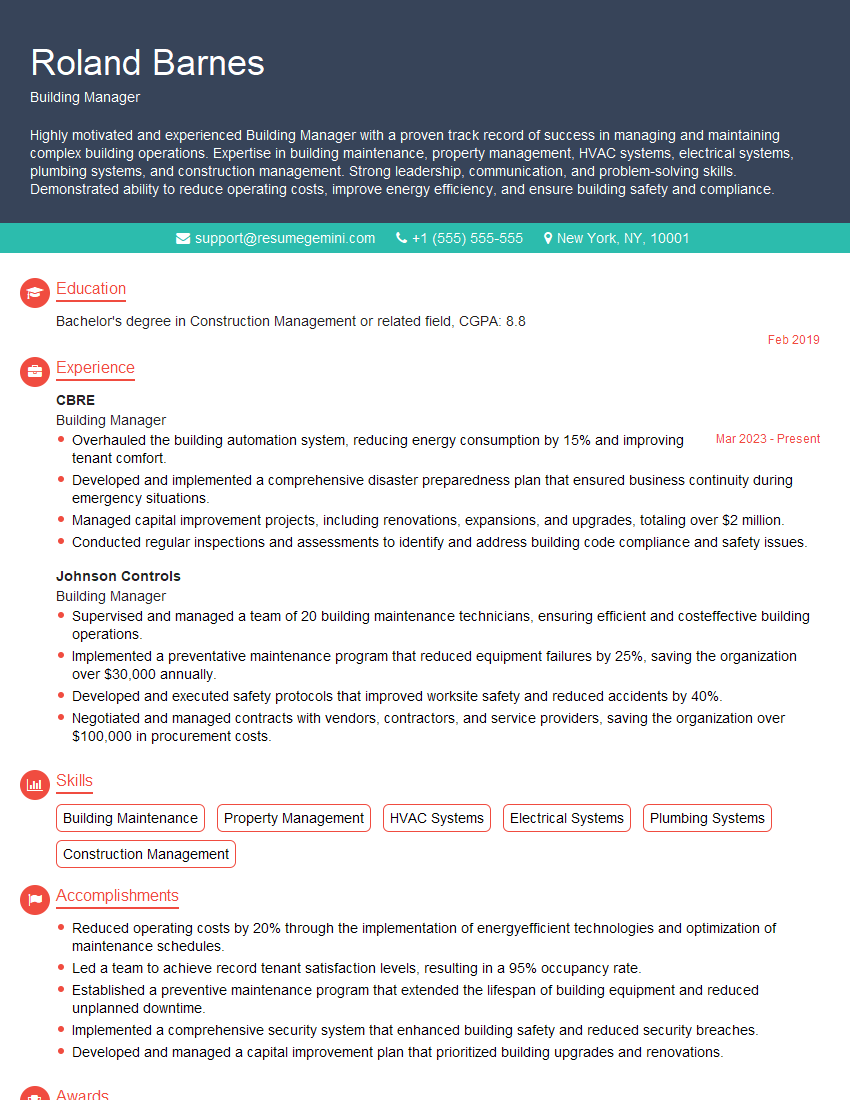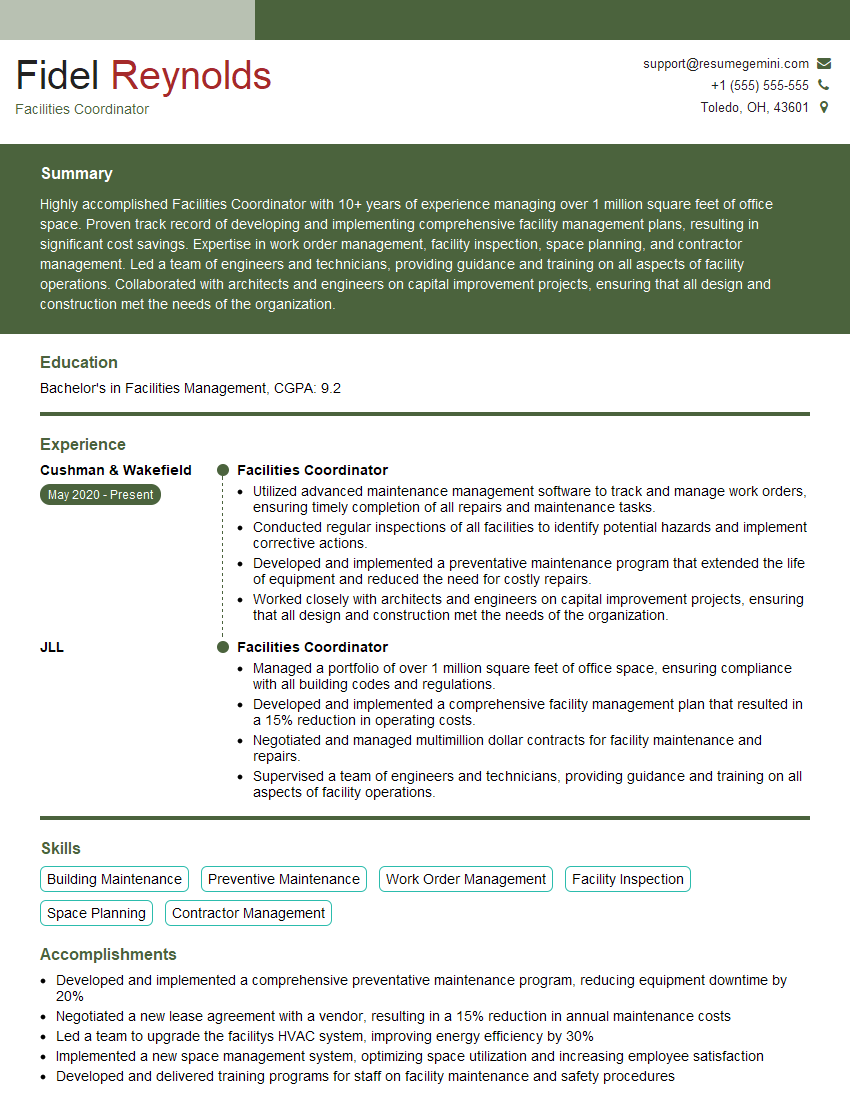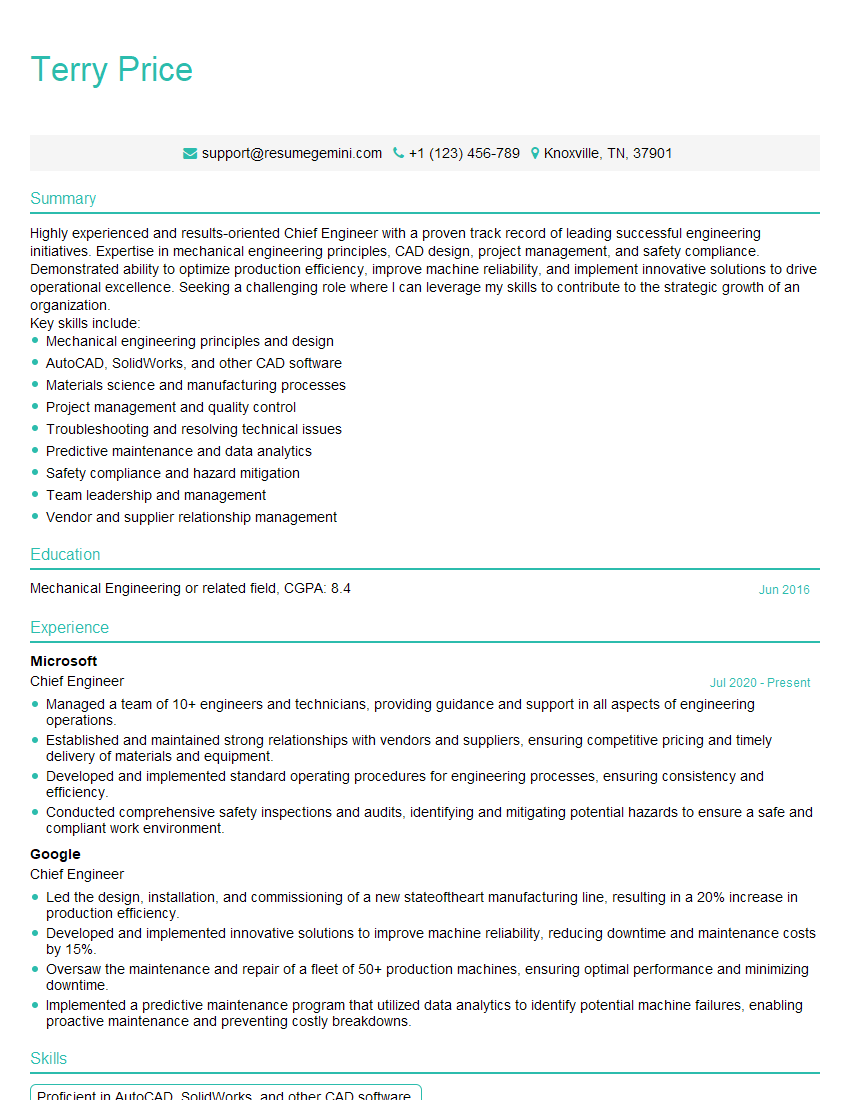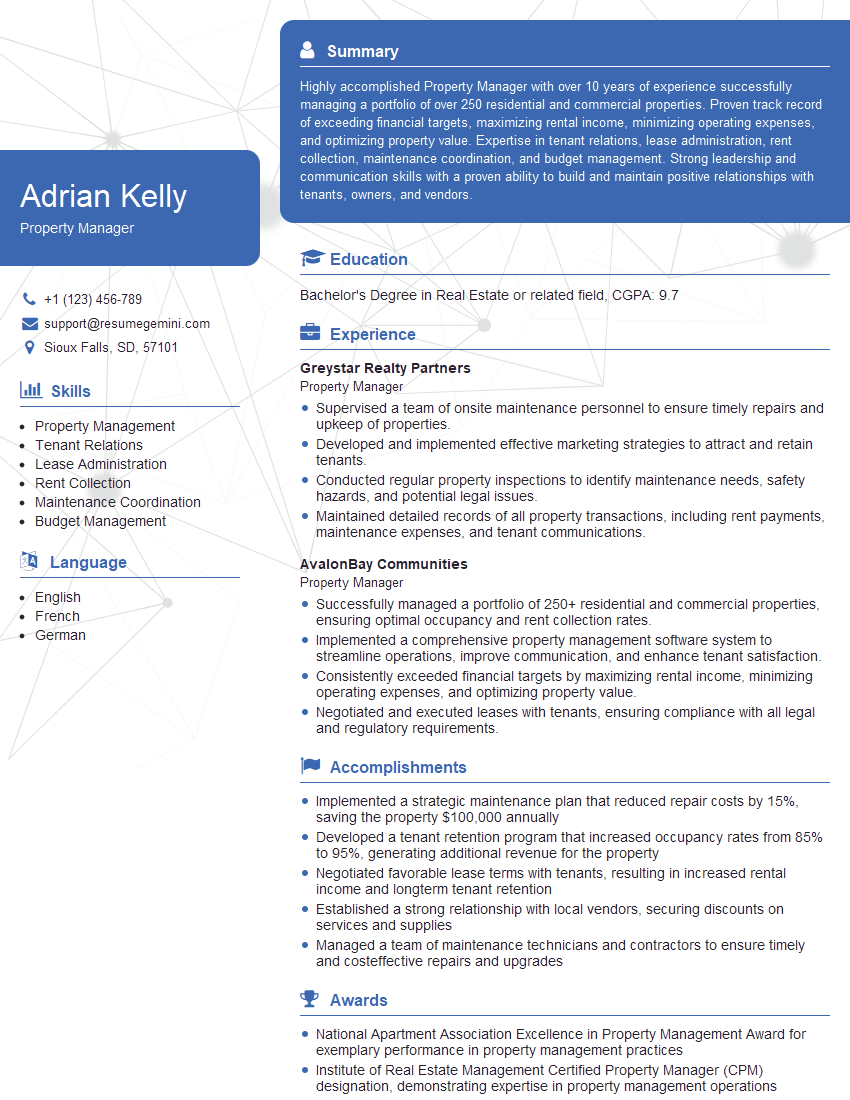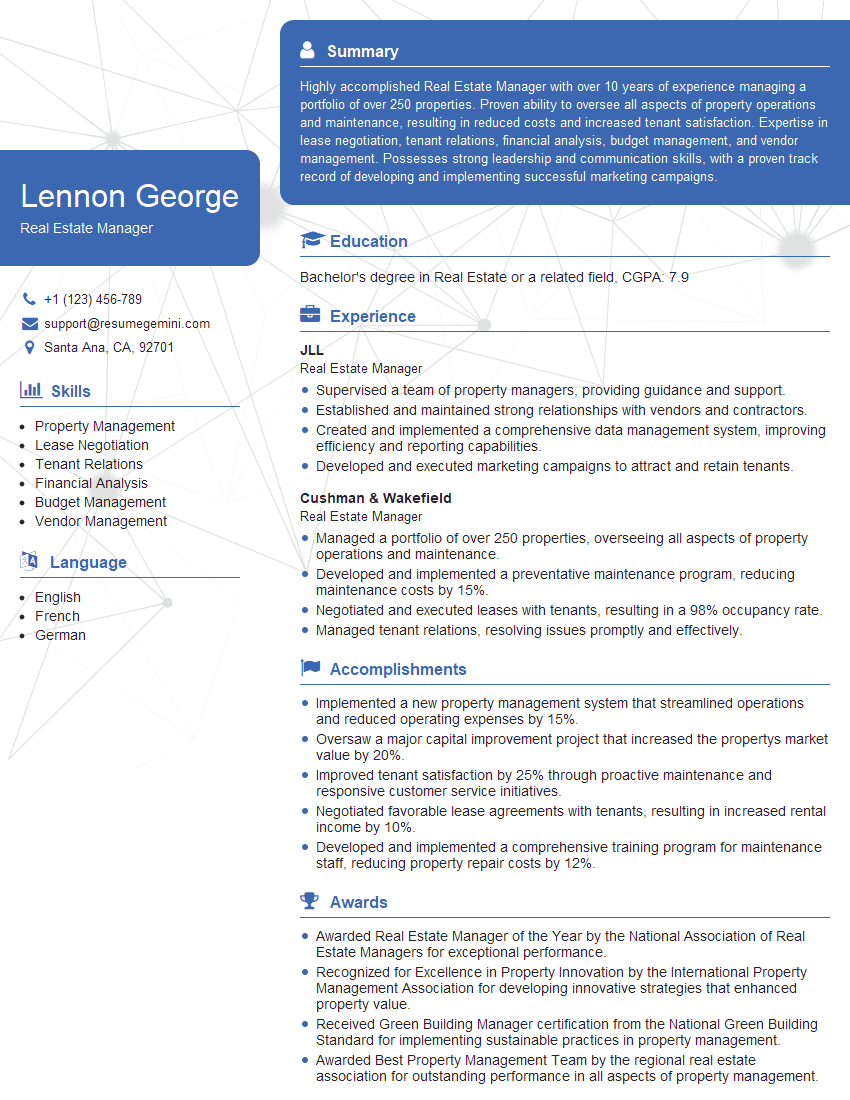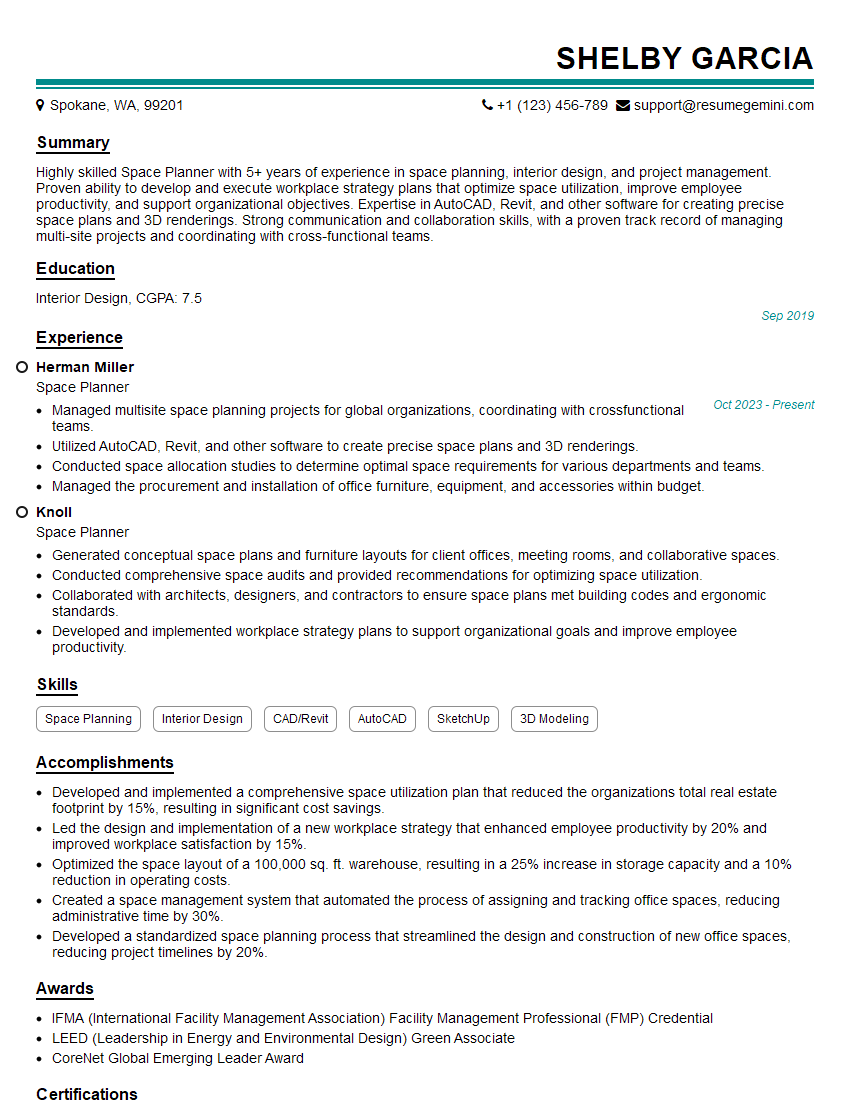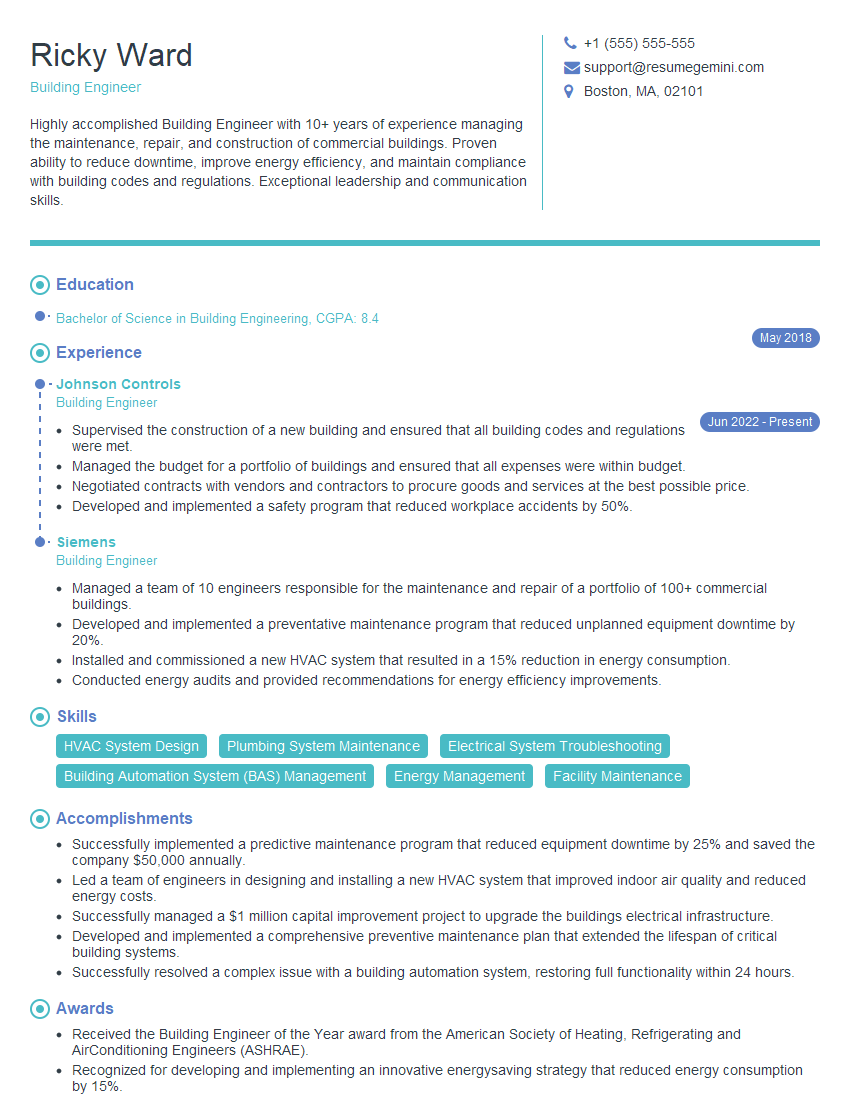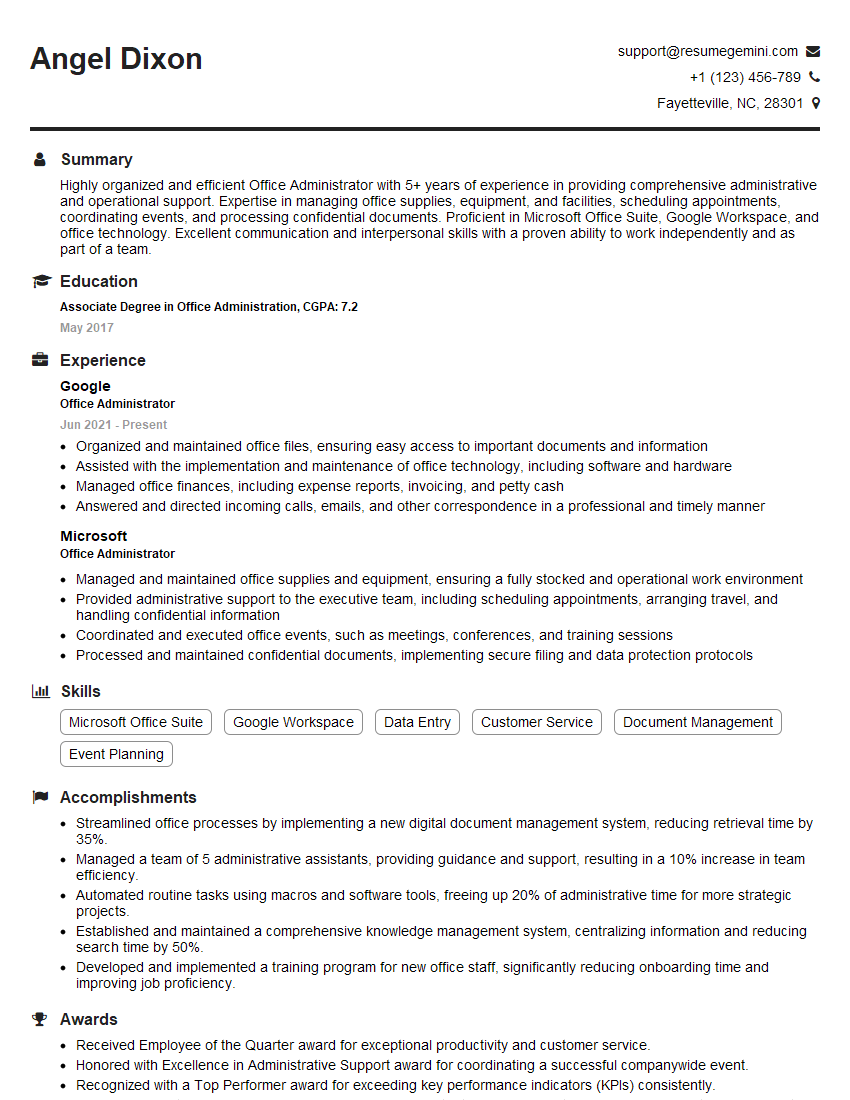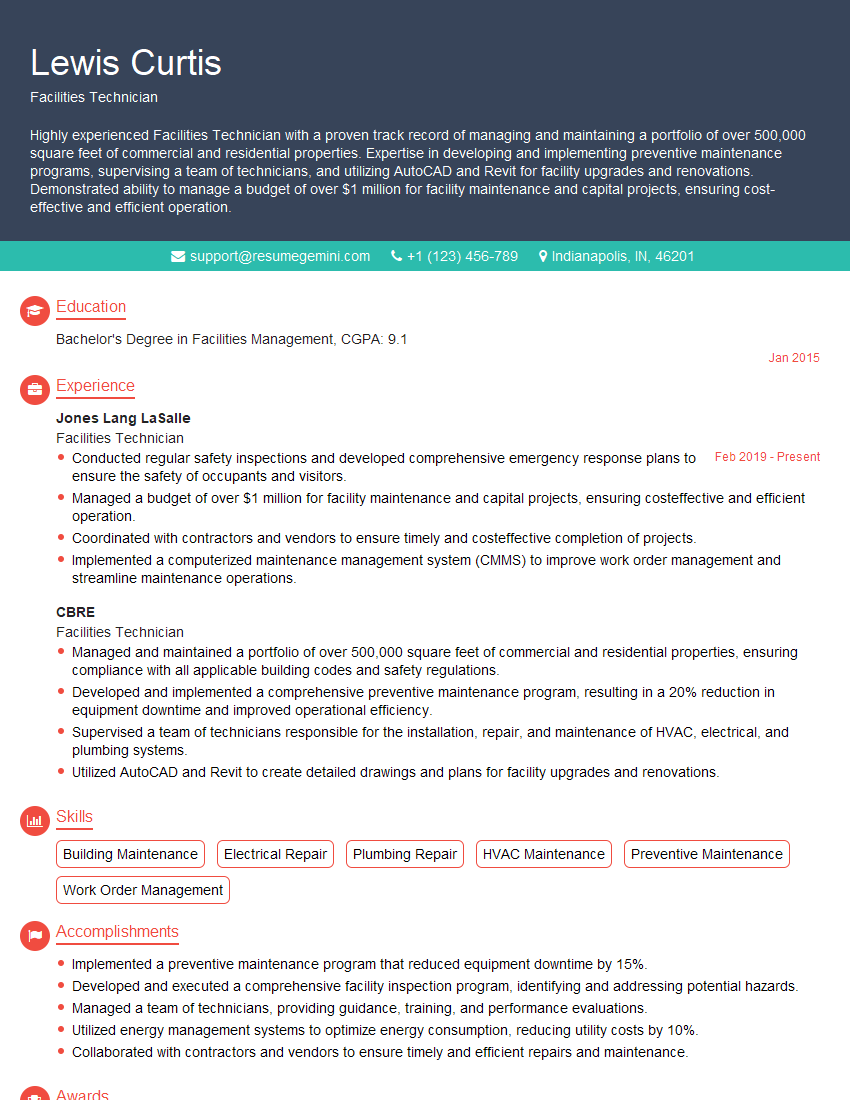Feeling uncertain about what to expect in your upcoming interview? We’ve got you covered! This blog highlights the most important Office and facilities management interview questions and provides actionable advice to help you stand out as the ideal candidate. Let’s pave the way for your success.
Questions Asked in Office and facilities management Interview
Q 1. Describe your experience managing budgets for facilities maintenance.
Managing facilities maintenance budgets requires a meticulous approach. It’s not just about tracking expenses; it’s about strategic allocation of resources to maximize operational efficiency and minimize costs. My process typically begins with a thorough assessment of the building’s needs, predicting potential maintenance requirements for the upcoming year. This involves reviewing historical data, identifying potential risks (e.g., aging equipment, deferred maintenance), and incorporating planned capital improvements.
Next, I develop a detailed budget, breaking down expenses into categories such as preventative maintenance, reactive repairs, equipment replacement, and contract services. I use budgeting software to track actual spending against the allocated budget, allowing me to identify variances early on. For example, if we’re consistently overspending on HVAC repairs, I’d investigate the root cause – perhaps it’s time for a preventative maintenance program or a more efficient system. Finally, I regularly report on budget performance to stakeholders, highlighting areas of concern and proposing corrective actions. In my previous role, I successfully reduced operational costs by 15% through proactive budget management and the implementation of a comprehensive preventative maintenance plan.
Q 2. How do you prioritize maintenance tasks and projects?
Prioritizing maintenance tasks is crucial for maintaining a safe and efficient facility. My approach uses a combination of methods, often referred to as a ‘triage’ system. Firstly, I classify tasks based on urgency and impact.
- Critical: Immediate attention needed to prevent safety hazards or significant disruptions (e.g., a major roof leak, power outage).
- Urgent: Requires prompt action to prevent further damage or inconvenience (e.g., malfunctioning HVAC unit, significant plumbing leak).
- Routine: Regular preventative maintenance to prevent future issues (e.g., air filter changes, equipment inspections).
- Deferred: Tasks that can be postponed without causing immediate harm but should be addressed eventually (e.g., cosmetic repairs, minor landscaping).
I then use a computerized maintenance management system (CMMS) to schedule and track tasks, assigning priorities and deadlines. The CMMS allows for efficient scheduling, tracking of work orders, and generation of reports that help visualize the workload and identify potential bottlenecks. This system helps me visualize the overall health of the building and makes informed decisions about resource allocation.
Q 3. Explain your process for selecting and managing vendors.
Selecting and managing vendors is a critical aspect of facilities management. I employ a rigorous process to ensure we partner with reliable and cost-effective providers. It starts with defining clear selection criteria, including experience, certifications, insurance coverage, financial stability, and references.
I then solicit bids from multiple vendors, ensuring a fair and competitive process. The bid evaluation includes a detailed review of proposals, considering factors such as pricing, proposed timelines, and the vendor’s understanding of our needs. Before awarding a contract, I thoroughly vet each vendor, verifying references and insurance.
Ongoing vendor management involves regular communication, performance reviews, and timely payments. I use key performance indicators (KPIs) to track vendor performance, addressing any issues promptly. This proactive management ensures we maintain high standards of service and avoid potential problems down the line. For example, we consistently track vendor response times for emergency repairs and their adherence to service level agreements (SLAs).
Q 4. How do you ensure compliance with building codes and safety regulations?
Compliance with building codes and safety regulations is paramount. I establish a robust compliance program that begins with a thorough understanding of all applicable codes and regulations, both local and national. This involves regularly reviewing updates and changes to the codes.
Next, I conduct regular inspections and audits to ensure compliance. This includes fire safety systems, electrical systems, and emergency exits. We maintain detailed records of inspections, repairs, and certifications. This documentation is crucial for demonstrating compliance to regulatory bodies. We also conduct employee training on safety procedures and emergency response plans. For instance, we provide regular fire safety training, including the proper use of fire extinguishers and evacuation procedures. In case of non-compliance, we develop a corrective action plan to address the issue promptly and prevent recurrence.
Q 5. What strategies do you use to improve energy efficiency in a building?
Improving energy efficiency is a key focus in modern facilities management. I employ a multifaceted approach, starting with an energy audit to identify areas of high energy consumption. This audit typically involves analyzing utility bills, inspecting equipment, and evaluating building systems.
Based on the audit results, I implement energy-saving measures, such as upgrading to energy-efficient lighting (LEDs), optimizing HVAC systems (through controls and regular maintenance), installing smart thermostats, and improving building insulation. I also promote energy conservation awareness among building occupants, encouraging them to switch off lights and electronics when not in use. By tracking energy consumption before and after the implementation of energy-saving measures, we can quantify the success of our initiatives. For example, in a past project, we achieved a 20% reduction in energy consumption through a combination of HVAC upgrades and occupant behavior changes.
Q 6. Describe your experience with space planning and optimization.
Space planning and optimization are crucial for maximizing the efficiency and functionality of a building. My process begins with understanding the organization’s needs and workflow. This includes interviewing employees to gather information about their space requirements and work patterns.
Next, I use space planning software to create different layouts, considering factors such as accessibility, ergonomics, and workflow optimization. This often involves using CAD (computer-aided design) software to create detailed floor plans and 3D models. I analyze the different layouts to determine the most efficient use of space, considering factors like maximizing natural light, minimizing travel distances, and creating collaborative work areas. Finally, I implement the chosen layout, coordinating with contractors and managing the relocation of furniture and equipment. Successful space optimization projects not only improve productivity but can also lead to cost savings by reducing the need for additional space.
Q 7. How do you handle emergency situations and building repairs?
Handling emergency situations and building repairs requires a swift and organized response. We have a well-defined emergency response plan that outlines procedures for various scenarios, including fire, flooding, power outages, and security breaches. This plan includes designated personnel, communication protocols, and evacuation procedures.
Upon detection of an emergency, I immediately activate the response plan, notifying relevant personnel and contacting emergency services if necessary. We maintain a list of reliable and readily available contractors for various types of repairs, enabling quick response times. After the immediate emergency is addressed, I conduct a thorough assessment of damages, documenting the incident and coordinating repairs with appropriate vendors. Post-incident reviews are critical for learning from experiences and improving our emergency response protocols. Detailed records of each emergency and the corrective actions taken are kept for insurance purposes and to prevent future occurrences.
Q 8. What is your experience with CMMS (Computerized Maintenance Management Systems)?
My experience with CMMS (Computerized Maintenance Management Systems) spans over ten years, encompassing implementation, training, and daily operational use. I’ve worked with various systems, including IBM Maximo, UpKeep, and Fiix, managing everything from preventative maintenance schedules to work order tracking and asset management. For instance, in my previous role at a large hospital complex, I spearheaded the implementation of IBM Maximo, which resulted in a 15% reduction in equipment downtime and a 10% decrease in maintenance costs within the first year. This involved meticulous data migration, rigorous training for maintenance staff, and the development of customized workflows tailored to the hospital’s specific needs. A key aspect of my approach is ensuring the system is user-friendly and integrated with other operational systems, such as inventory management and procurement. This integration prevents data silos and provides a holistic view of the facility’s operational efficiency.
Beyond simple work order management, I leverage CMMS analytics to proactively identify maintenance needs and predict potential equipment failures. This predictive maintenance approach allows for timely interventions, minimizing costly repairs and preventing disruptions to services. For example, by analyzing historical data on HVAC unit performance, we were able to predict a critical failure and schedule preventative maintenance, avoiding a costly emergency repair and ensuring uninterrupted climate control for the entire facility. This proactive approach is key to maximizing the return on investment in a CMMS and improving overall facility efficiency.
Q 9. How do you manage tenant relations and address their concerns?
Managing tenant relations is paramount to a successful facilities management operation. I approach it as a collaborative partnership, focusing on proactive communication and prompt issue resolution. My strategy revolves around clear and consistent communication channels – regular newsletters, easily accessible online portals for submitting requests, and scheduled tenant meetings to address concerns and solicit feedback.
When addressing tenant concerns, I utilize a structured approach: I actively listen, empathize with their situation, and thoroughly investigate the issue. Once the root cause is identified, I develop a tailored solution, keeping the tenant informed every step of the way, providing realistic timelines and managing expectations effectively. For example, if a tenant reports a persistent plumbing issue, I’ll not only dispatch a plumber immediately but also ensure they are updated regularly on the repair progress, and follow up post-repair to ensure their satisfaction. Building rapport and trust through transparency and prompt action is crucial in fostering positive tenant relationships. This proactive approach minimizes conflicts and ensures high tenant retention.
Q 10. What is your experience with lease negotiations and administration?
My experience with lease negotiations and administration encompasses all aspects from initial due diligence and contract review to ongoing compliance and renewal. I have successfully negotiated numerous leases for various types of properties, including office spaces, retail units, and industrial facilities. This involves understanding market rates, lease terms, and legal implications. I’m adept at identifying potential risks and opportunities within lease agreements and advocating for favorable terms on behalf of the organization.
During the negotiation phase, I meticulously review lease documents, identify areas of potential conflict or ambiguity, and negotiate terms that protect the organization’s interests while maintaining a mutually beneficial relationship with the landlord. Post-negotiation, I’m responsible for ongoing lease administration, including rent payments, compliance with lease terms, and timely communication with the landlord. For example, in a recent negotiation, I identified a clause in the lease that allowed for significant cost savings on utilities by renegotiating the allocation of shared expenses. This resulted in substantial annual savings for the company. Strong lease administration ensures compliance, minimizes disputes, and maximizes the value of our leased properties.
Q 11. Describe your experience with risk assessment and mitigation in facilities management.
Risk assessment and mitigation is an integral part of my facilities management approach. I use a systematic approach, employing a combination of quantitative and qualitative methods to identify, analyze, and manage potential risks. This includes conducting regular facility inspections, reviewing historical data on incidents, and employing risk assessment tools. I prioritize a proactive approach, aiming to prevent risks from materializing rather than simply reacting to them.
For instance, a comprehensive risk assessment might identify potential hazards like fire, flooding, or security breaches. For each identified hazard, we develop mitigation strategies, which could involve installing fire suppression systems, implementing flood prevention measures, and enhancing security protocols, including access control and surveillance systems. After implementing the mitigation strategies, ongoing monitoring and evaluation are vital. This includes tracking the effectiveness of our mitigation measures and making adjustments as needed. Regular reviews and updates to the risk assessment are crucial in adapting to changing conditions and emerging threats. This ensures the safety and security of the occupants and the protection of the facility’s assets.
Q 12. How do you handle conflicting priorities among multiple projects?
Handling conflicting priorities among multiple projects requires a structured and methodical approach. I prioritize projects based on a variety of factors, including urgency, impact, and alignment with overall strategic goals. I utilize project management tools such as Gantt charts and Kanban boards to visualize project timelines, dependencies, and resource allocation.
Clear communication and collaboration are key. I hold regular meetings with stakeholders to discuss priorities, potential conflicts, and develop solutions. This ensures everyone is informed and aligned. Sometimes, compromises are necessary. I might suggest phasing projects or adjusting timelines to accommodate competing needs. For example, a small, urgent repair might temporarily take precedence over a larger, long-term renovation project. Through careful planning, clear communication, and a willingness to adapt, I ensure that all crucial projects progress smoothly and efficiently, while minimizing disruption and delays.
Q 13. What metrics do you use to track the performance of your facilities management team?
Tracking the performance of my facilities management team involves a comprehensive set of Key Performance Indicators (KPIs). These metrics are carefully selected to reflect our key objectives, including cost efficiency, operational effectiveness, and tenant satisfaction.
Examples of KPIs I use include:
- Maintenance response time: Measures the time it takes to respond to and resolve maintenance requests.
- Preventative maintenance compliance rate: Tracks the percentage of scheduled preventative maintenance tasks completed on time.
- Equipment downtime: Measures the time equipment is out of service due to malfunction.
- Tenant satisfaction scores: Gathered through surveys and feedback mechanisms.
- Cost per square foot: Tracks the cost of facilities management relative to the size of the facility.
- Energy consumption: Measures energy usage to assess efficiency and identify areas for improvement.
Regular monitoring of these KPIs allows for identification of trends, areas for improvement, and objective assessment of team performance. This data-driven approach enables us to continuously optimize our processes and deliver exceptional results.
Q 14. Explain your experience with sustainability initiatives in facilities management.
Sustainability is a core principle in my facilities management philosophy. I integrate environmentally friendly practices into all aspects of our operations, aiming to reduce our environmental footprint and contribute to a more sustainable future. This encompasses energy efficiency, water conservation, waste reduction, and the procurement of sustainable materials.
Specific initiatives I have implemented include:
- Energy efficiency upgrades: Installing LED lighting, upgrading HVAC systems, and implementing energy management systems.
- Water conservation measures: Implementing low-flow fixtures, repairing leaks promptly, and educating occupants on water conservation practices.
- Waste reduction programs: Implementing recycling programs, composting organic waste, and reducing reliance on single-use plastics.
- Sustainable procurement: Prioritizing the use of recycled and locally sourced materials whenever possible.
- Green building certifications: Pursuing certifications like LEED (Leadership in Energy and Environmental Design) to demonstrate our commitment to sustainability.
By consistently incorporating these sustainable practices, we reduce operational costs, improve the environmental performance of our facilities, and foster a culture of environmental responsibility within the organization.
Q 15. How do you ensure the safety and security of building occupants?
Ensuring the safety and security of building occupants is paramount. It’s a multifaceted approach encompassing proactive measures and reactive responses. Think of it like creating a layered security system for a castle – multiple defenses working together.
Access Control: Implementing robust access control systems, such as key card entry, security cameras, and visitor logs, restricts unauthorized entry and tracks movements within the building. For instance, in a previous role, we implemented a system that integrated with employee badges, eliminating the need for physical keys and instantly alerting security of any unauthorized access attempts.
Emergency Procedures: Clearly defined emergency procedures, including evacuation plans, fire drills, and first-aid protocols, are crucial. These aren’t just documents; they need regular training and practice. We used a gamified approach in one building to increase engagement during fire drill practice, significantly improving response times.
Security Personnel: Depending on the building’s size and risk profile, employing security personnel can add another layer of protection. Their presence can deter crime and provide immediate response to incidents. This might include regular patrols, monitoring security systems, and interacting with building occupants.
Maintenance and Inspections: Regular inspections of security systems, fire alarms, emergency lighting, and other safety equipment are vital to ensure they function correctly. A breakdown in any of these systems could compromise safety. I’ve personally overseen a program that used predictive maintenance analysis to anticipate potential issues before they became safety hazards.
Communication: Effective communication channels – emergency alerts, regular updates, and clear signage – keep occupants informed and prepared. In one case, we implemented a mobile app to directly communicate emergency notifications and building updates, significantly improving response times and reducing anxiety during crises.
Career Expert Tips:
- Ace those interviews! Prepare effectively by reviewing the Top 50 Most Common Interview Questions on ResumeGemini.
- Navigate your job search with confidence! Explore a wide range of Career Tips on ResumeGemini. Learn about common challenges and recommendations to overcome them.
- Craft the perfect resume! Master the Art of Resume Writing with ResumeGemini’s guide. Showcase your unique qualifications and achievements effectively.
- Don’t miss out on holiday savings! Build your dream resume with ResumeGemini’s ATS optimized templates.
Q 16. How do you develop and manage a preventative maintenance program?
A preventative maintenance program is the backbone of efficient and cost-effective facilities management. It’s about proactively addressing potential issues before they escalate into costly repairs or disruptions. Imagine it like regular check-ups for your car – preventing major problems down the line.
Asset Inventory: The first step is creating a comprehensive inventory of all building assets – HVAC systems, elevators, fire safety equipment, etc. This inventory should include details like make, model, purchase date, and maintenance history.
Maintenance Schedules: Develop a detailed schedule outlining routine maintenance tasks for each asset based on manufacturer recommendations and best practices. This could involve regular cleaning, lubrication, inspections, and replacements. We used CMMS software (Computerized Maintenance Management System) to automate this process, generating work orders and tracking completion.
Work Order Management: Establish a system for tracking work orders, assigning tasks to maintenance personnel, and monitoring completion. Clear communication and documentation are crucial at this stage.
Performance Monitoring: Regularly monitor the performance of building systems and equipment to identify trends and potential problems early on. Data analysis can help predict failures and optimize maintenance schedules.
Budgeting and Resource Allocation: Allocate sufficient budget and resources to support the preventative maintenance program. This includes personnel, equipment, parts, and training.
For example, in one project, we implemented a predictive maintenance system for our HVAC units, reducing energy consumption by 15% and minimizing unexpected breakdowns.
Q 17. How do you handle complaints from building occupants?
Handling complaints effectively is crucial for maintaining positive occupant relations. It’s about turning a negative experience into an opportunity to improve service and build trust. Think of it like a customer service interaction, but with a focus on building maintenance.
Establish a Formal Complaint System: Create a clear process for submitting complaints – online forms, phone lines, email addresses, etc. Make sure it is easy to use and accessible to all occupants.
Acknowledge and Respond Promptly: Acknowledge receipt of every complaint promptly and inform the occupant of the next steps. A timely response is crucial for demonstrating responsiveness.
Investigate Thoroughly: Investigate the complaint thoroughly to determine the root cause. This may involve inspections, interviews, and reviewing relevant data.
Take Corrective Action: Take appropriate corrective action to resolve the complaint and prevent it from happening again. This might involve repairs, policy changes, or staff training.
Follow Up: Follow up with the occupant to ensure the issue has been resolved to their satisfaction. This shows you care about their experience and fosters trust.
For example, in one building we had recurring complaints about elevator performance. By analyzing maintenance logs and passenger feedback, we identified a pattern of wear and tear in a specific component. Replacing these components resolved the issue and prevented future complaints.
Q 18. Describe your experience with managing facility renovations or construction projects.
I have extensive experience managing facility renovations and construction projects, from initial planning and budgeting to completion and occupancy. This involves coordinating multiple stakeholders, managing budgets, and ensuring projects are completed on time and within budget.
Project Planning and Budgeting: I develop detailed project plans, including scopes of work, timelines, and budgets. This includes identifying potential risks and developing mitigation strategies.
Vendor Management: I manage relationships with contractors, subcontractors, and suppliers, ensuring they meet project specifications and timelines.
Construction Oversight: I oversee the construction process, ensuring compliance with building codes, safety regulations, and project specifications.
Occupancy Planning: I coordinate the transition from construction to occupancy, including cleaning, furniture installation, and staff training.
Post-Construction Evaluation: I conduct post-construction evaluations to identify lessons learned and areas for improvement in future projects.
In a recent project involving a major office renovation, we successfully completed the work with minimal disruption to building occupants, exceeding expectations in terms of quality and timeline. This involved meticulous planning, proactive communication, and strong collaboration with contractors and building occupants.
Q 19. What software or tools do you use for facilities management?
Effective facilities management relies on leveraging appropriate software and tools. I’ve utilized a variety of tools throughout my career, adapting my approach based on specific needs and project requirements.
CMMS (Computerized Maintenance Management System): Software like UpKeep, Fiix, or IBM Maximo are invaluable for managing preventative maintenance, work orders, and asset tracking. They provide a centralized platform for managing all aspects of maintenance.
CAFM (Computer-Aided Facility Management): Software such as Archibus or Planon helps with space management, planning, and resource allocation. This allows for efficient space utilization and informed decision-making related to facility layout and expansion.
BIM (Building Information Modeling): Software like Revit or ArchiCAD allows for 3D modeling of building assets, aiding in design, construction, and ongoing maintenance planning. This enhances collaboration and provides valuable insights throughout the project lifecycle.
Project Management Software: Tools like Microsoft Project, Asana, or Monday.com facilitate project tracking, task management, and resource allocation during renovations or construction projects.
The selection of specific software depends on the size and complexity of the facility, budget, and specific needs. I’m proficient in adapting my use of these tools to different contexts.
Q 20. How do you ensure compliance with environmental regulations?
Ensuring compliance with environmental regulations is a crucial aspect of responsible facilities management. This involves understanding and adhering to local, regional, and national regulations, protecting both the environment and the building’s occupants.
Waste Management: Implementing a comprehensive waste management program, including recycling, composting, and hazardous waste disposal, is essential. We developed a program in one building that reduced waste by 20% through improved recycling and composting initiatives.
Energy Efficiency: Implementing energy-efficient practices, such as upgrading lighting systems, optimizing HVAC systems, and employing smart building technologies, reduces the environmental impact of the building and lowers operating costs. I’ve overseen projects that have achieved LEED certification through effective energy management strategies.
Water Conservation: Implementing water-saving measures, such as low-flow fixtures, rainwater harvesting, and landscape management, reduces water consumption and environmental impact.
Air Quality: Maintaining indoor air quality through regular air filter replacements, ventilation, and monitoring for pollutants is vital for occupant health and well-being.
Compliance Tracking: Establish a system for tracking compliance with regulations and permits. Regular audits and inspections are important for ongoing compliance.
For example, we successfully implemented a comprehensive sustainability plan in a previous role that resulted in significant reductions in energy and water consumption, earning several environmental awards.
Q 21. What is your experience with developing and implementing emergency response plans?
Developing and implementing effective emergency response plans is crucial for protecting building occupants and minimizing disruptions during crises. This is not a one-time task; it requires regular review, updates, and training.
Risk Assessment: Conduct a thorough risk assessment to identify potential hazards and vulnerabilities. This could include natural disasters, fire, security breaches, or power outages.
Emergency Plan Development: Develop detailed emergency plans outlining procedures for various scenarios. This includes evacuation procedures, communication protocols, and response teams.
Training and Drills: Conduct regular training sessions and drills to familiarize occupants and staff with emergency procedures. These exercises should simulate realistic scenarios to ensure preparedness.
Communication Systems: Ensure reliable communication systems, including emergency alert systems, public address systems, and backup communication channels, are in place.
Post-Incident Review: Conduct post-incident reviews to evaluate the effectiveness of the emergency response plan and identify areas for improvement. This ensures continuous improvement and adaptability.
In a previous role, we developed and implemented a comprehensive emergency response plan that successfully guided the building’s occupants during a major power outage. Regular drills and clear communication ensured a safe and orderly evacuation and restoration of services.
Q 22. How do you manage and track facility assets?
Managing and tracking facility assets is crucial for efficiency and cost-effectiveness. My approach involves a multi-pronged strategy leveraging both technology and established procedures. Firstly, I implement a comprehensive Computerized Maintenance Management System (CMMS). This software allows for detailed asset registration, including specifications, location, maintenance history, and associated costs. Think of it like a detailed digital inventory of everything from furniture to HVAC systems. Secondly, I employ a robust barcode or RFID tagging system for easy identification and tracking of assets. This allows for quick inventory checks, streamlined maintenance scheduling, and accurate depreciation calculations. For example, if a piece of equipment requires repair, the CMMS provides immediate access to its maintenance history, allowing for quicker diagnosis and resolution. Regular audits, both physical and digital, ensure the CMMS data remains accurate and up-to-date.
Finally, I establish clear procedures for asset disposal and replacement, including documentation and approvals. This ensures we maintain a comprehensive record of all assets throughout their lifecycle and avoid unnecessary expenses from duplicate purchases or neglecting asset maintenance.
Q 23. How do you communicate effectively with different stakeholders (tenants, staff, vendors)?
Effective communication is paramount in facilities management. I tailor my communication style to the specific audience. With tenants, I prioritize clarity, responsiveness, and professionalism. This involves clear and concise updates on maintenance schedules, planned disruptions, and policy changes. I utilize multiple channels like email, newsletters, and even regular tenant meetings to foster transparency and address concerns proactively. For staff, I focus on clear task assignments, regular feedback, and opportunities for training and development. Open communication fosters collaboration and accountability. With vendors, I utilize formal contracts, detailed service level agreements (SLAs), and regular performance reviews to ensure quality service and adherence to timelines and budgets.
For instance, during a major renovation project, I used a dedicated project management software to update tenants on the progress and any associated inconveniences. Simultaneously, I held regular meetings with my team to manage tasks and address challenges quickly. This multi-faceted approach ensured everyone was informed and could contribute effectively.
Q 24. What is your experience with cost control and budget management in facilities?
Cost control and budget management are cornerstones of successful facilities management. I begin with detailed budgeting and forecasting, incorporating historical data, anticipated maintenance requirements, and potential cost escalations. This involves a thorough review of past expenditures, anticipating future needs, and incorporating contingency plans. I regularly monitor expenditures against the budget, using the CMMS to track maintenance costs, energy consumption, and other key metrics. We use data analytics to identify areas for potential cost savings. For example, by analyzing energy usage patterns, we were able to implement energy-efficient lighting systems, resulting in a significant reduction in electricity costs.
Furthermore, I proactively seek opportunities for cost optimization, such as negotiating favorable contracts with vendors, implementing preventative maintenance programs to avoid costly repairs, and exploring energy-saving technologies. Regular reporting to stakeholders ensures transparency and facilitates informed decision-making. A key to success is leveraging data and technology – monitoring actual vs. budgeted costs in real-time to identify potential overruns early on.
Q 25. How do you delegate tasks and manage your team effectively?
Effective team management involves delegation, empowerment, and consistent communication. I begin by clearly defining roles and responsibilities, ensuring each team member understands their tasks and how they contribute to the overall goals. I delegate tasks based on individual strengths and skill sets, empowering team members to take ownership and make decisions within their areas of expertise. This promotes a sense of responsibility and fosters professional growth. Regular one-on-one meetings and team meetings provide opportunities for feedback, problem-solving, and skill development. I provide regular updates and support to my team, fostering a collaborative and supportive work environment.
For example, when managing a large-scale cleaning project, I assigned tasks to different teams based on their specialization and experience. This ensured efficiency and high-quality results. I utilized project management tools to track progress, address issues promptly, and provide regular feedback to keep the team informed and motivated.
Q 26. Describe a time you had to solve a complex facilities problem. What was your approach?
One challenging situation involved a major HVAC system failure during a severe heatwave. The system served a critical section of our building, and the failure posed a significant risk to both occupants and operations. My approach was systematic and prioritized swift action. First, I activated our emergency response plan, ensuring occupant safety and contacting emergency services as needed. Then, I coordinated with our maintenance team to assess the damage, identify the root cause, and develop a temporary solution. Simultaneously, I initiated contact with several HVAC vendors to secure expedited repairs and prevent prolonged disruption.
We used a combination of temporary cooling units and creative ventilation solutions to minimize discomfort while awaiting repairs. Through clear communication with building occupants, we managed expectations and mitigated potential frustration. The prompt action prevented significant financial losses and potential damage to equipment. Post-incident, I performed a root cause analysis to understand the failure’s origins and implemented preventive measures to avoid similar incidents in the future.
Q 27. How do you stay current with the latest trends and technologies in facilities management?
Staying current in facilities management requires continuous learning and engagement with industry advancements. I regularly attend industry conferences and webinars, participating in professional organizations like IFMA (International Facility Management Association) to network with peers and learn about best practices. I actively read industry publications and journals, subscribing to relevant newsletters, and following key influencers on social media. I also encourage my team to participate in professional development opportunities, fostering a culture of continuous learning and improvement. This keeps our facility management strategies aligned with industry best practices and allows us to incorporate new technologies effectively. For example, I recently explored integrating smart building technologies to optimize energy consumption and improve facility performance.
Q 28. What are your salary expectations for this role?
My salary expectations for this role are commensurate with my experience and the requirements of the position. After reviewing the job description and considering the scope of responsibilities and compensation benchmarks for similar roles in the market, my salary expectation is between [Insert Salary Range]. I am confident that my skills and experience will provide significant value to your organization and am open to discussing this further.
Key Topics to Learn for Office and Facilities Management Interviews
- Space Planning and Optimization: Understanding principles of efficient space utilization, including maximizing functionality and minimizing costs. Practical application: Designing layouts to improve workflow and employee satisfaction.
- Budget Management and Financial Reporting: Developing and managing budgets, tracking expenses, and preparing accurate financial reports. Practical application: Negotiating contracts with vendors to secure the best value.
- Health and Safety Regulations: Comprehensive knowledge of relevant legislation (e.g., OSHA) and implementing safety protocols to maintain a safe work environment. Practical application: Conducting regular safety inspections and implementing corrective actions.
- Vendor Management: Selecting, negotiating with, and managing contracts with various service providers (cleaning, maintenance, security). Practical application: Evaluating vendor performance and addressing service issues.
- Facilities Maintenance and Repair: Overseeing preventative and reactive maintenance, coordinating repairs, and managing facility assets. Practical application: Developing and implementing a preventative maintenance schedule.
- Sustainability and Energy Efficiency: Implementing strategies to reduce environmental impact and energy consumption. Practical application: Implementing energy-saving initiatives, such as upgrading lighting or implementing recycling programs.
- Technology and Automation: Utilizing technology (e.g., CMMS software) to streamline operations and improve efficiency. Practical application: Implementing a computerized maintenance management system to track work orders and assets.
- Communication and Teamwork: Effectively communicating with staff, vendors, and stakeholders. Practical application: Managing diverse teams and resolving conflicts efficiently.
- Project Management: Planning, executing, and monitoring facility projects within budget and timelines. Practical application: Managing renovations or construction projects.
Next Steps
Mastering Office and Facilities Management opens doors to rewarding careers with significant growth potential. A strong grasp of these key areas will significantly enhance your interview performance and career prospects. Creating an ATS-friendly resume is crucial for getting your application noticed by recruiters. We strongly encourage you to utilize ResumeGemini to build a professional and impactful resume that highlights your skills and experience effectively. ResumeGemini provides examples of resumes tailored specifically to Office and Facilities Management roles, helping you craft a document that stands out from the competition.
Explore more articles
Users Rating of Our Blogs
Share Your Experience
We value your feedback! Please rate our content and share your thoughts (optional).
What Readers Say About Our Blog
Hi, I’m Jay, we have a few potential clients that are interested in your services, thought you might be a good fit. I’d love to talk about the details, when do you have time to talk?
Best,
Jay
Founder | CEO

